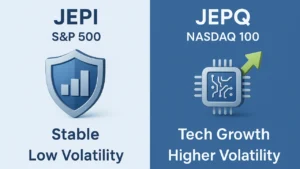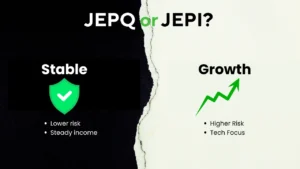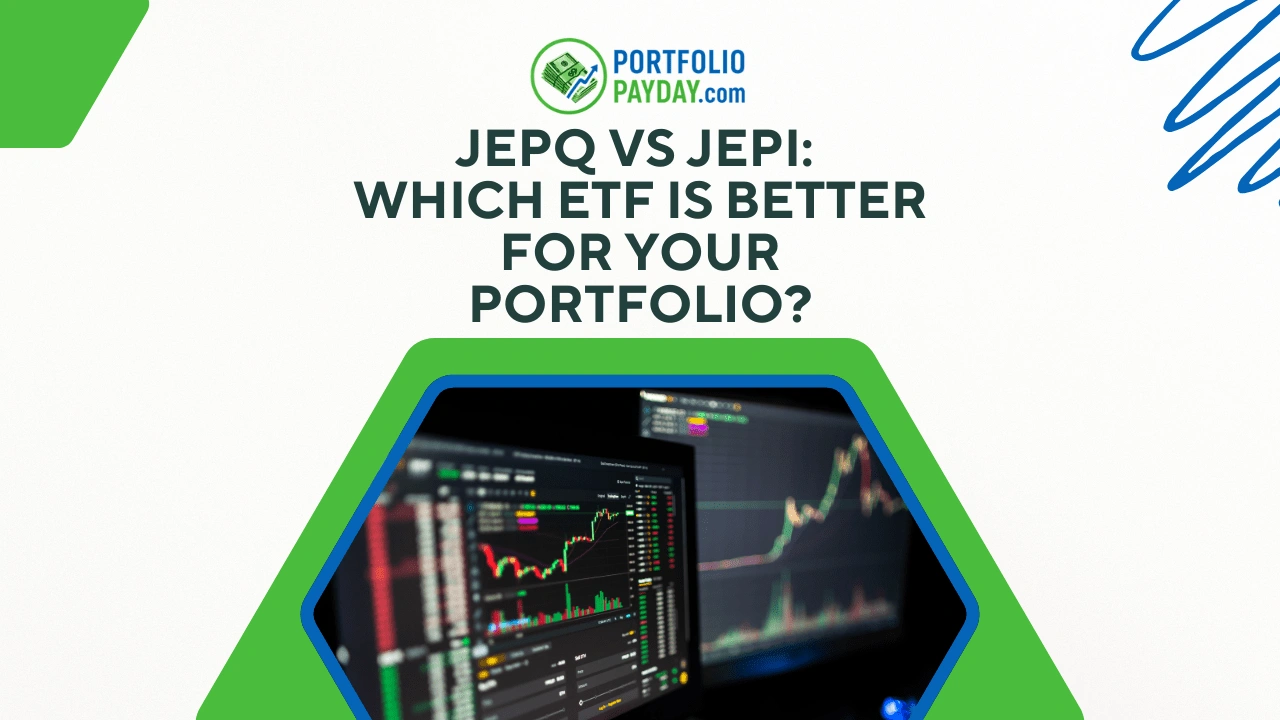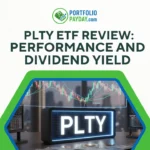Disclaimer: The following is for informational purposes only and not financial advice. Always do your own due diligence. I am not a licensed advisor.
JEPQ vs JEPI: Which Covered Call ETF Should You Choose?
If you’re searching for an ETF that balances strong income generation with growth potential, you’ve likely encountered JEPQ and JEPI—two popular covered call ETFs from JP Morgan. Both have garnered attention for their high yields and monthly dividend payouts, but how do they stack up against each other? In this article, we’ll dive deep into the JEPQ vs JEPI debate, analyzing their performance, strategies, and which one might be a better fit for your investment goals.
What Are JEPQ and JEPI?
At their core, both JEPQ (JP Morgan NASDAQ Equity Premium Income ETF) and JEPI (JP Morgan Equity Premium Income ETF) are designed to generate monthly income through the use of a covered call strategy. But while the strategy is the same, the underlying indices they track and their focus areas differ, leading to distinct outcomes for investors.
- JEPI focuses on large-cap, low-volatility stocks in the S&P 500, which are typically more stable and resilient, making it less volatile than the broader market.
- JEPQ, on the other hand, targets the NASDAQ 100, which leans heavily into tech stocks like Apple, Microsoft, and Nvidia. This gives it more growth potential but also comes with higher volatility.

Let’s break it down further to see how these differences affect their overall performance.
The Income Factor: Dividends and Yield
One of the primary reasons investors flock to JEPQ and JEPI is their high dividend yield. Both ETFs offer attractive monthly payouts, which are appealing to those looking to generate passive income.
- JEPI typically offers a dividend yield of around 7% to 9%, providing a stable income stream, especially in times of market volatility. With its focus on the S&P 500, JEPI tends to be a safer bet for those prioritizing consistent, reliable income.
- JEPQ yields higher, generally in the 10% to 12% range. This is due to the higher volatility of the NASDAQ 100, which allows for larger premiums when selling covered calls. If you’re looking for more immediate income and can tolerate higher volatility, JEPQ might be a better fit.
Performance: Balancing Growth and Stability
While high yields are essential, it’s also crucial to consider the performance of these ETFs over time. How much have they grown in value? Let’s take a closer look at how each has fared in recent years.
JEPI:
Since its inception in May 2020, JEPI has performed steadily, with a 5.5% to 9% total return over the past few years. Its conservative approach, focusing on large-cap stable companies, has made it a reliable income producer. The downside? Limited price appreciation. Since JEPI sells covered calls, it sacrifices some potential upside in exchange for the predictable monthly premiums.
JEPQ:
JEPQ, launched in May 2022, has experienced a more volatile ride, as it is heavily weighted in the tech sector. The tech-heavy NASDAQ 100 has outperformed the broader market in recent years, leading JEPQ to a higher growth potential. In fact, JEPQ has had a total return of around 29% annually, outperforming JEPI and many other income-focused funds during bull markets. However, it’s important to remember that JEPQ’s volatility can also result in larger swings during market corrections or bear markets.
Risk: Volatility vs Stability
As with any investment, it’s important to consider the risk involved. Both JEPQ and JEPI have relatively low expense ratios of 0.35%, but their volatility differs greatly:
- JEPI is less volatile thanks to its S&P 500 exposure, with a volatility rating of 1.79%. It’s well-suited for those seeking more stability and lower risk, making it ideal for conservative investors or retirees looking to protect their capital while generating income.
- JEPQ, with its tech-heavy focus, has a volatility of 2.19%. This makes it riskier, but also gives it the potential for higher returns. If you’re comfortable with the ups and downs of the tech market, JEPQ might offer higher rewards.

Taxes: The Impact of Covered Calls
The covered call strategy used by both funds involves selling options on their underlying assets, which generates option premiums—this is the income investors receive. However, there’s a tax impact to consider. Since the income generated from covered calls is often classified as ordinary income rather than qualified dividends, investors may face higher taxes on this income.
- JEPI generally provides a higher percentage of qualified dividends, which are taxed at a lower rate compared to ordinary income.
- JEPQ, however, has a larger portion of its income classified as ordinary income, making it subject to higher taxes. While this may not be a deal breaker for all investors, it’s an important factor to keep in mind when choosing between the two.
Which ETF Is Right for You?
So, which ETF should you choose: JEPQ or JEPI? The answer depends on your personal investment goals and risk tolerance:
- Choose JEPI if you want stability and are focused on consistent income with lower risk. It’s ideal for those seeking steady cash flow without the wild market swings that come with tech-heavy ETFs.
- Choose JEPQ if you’re comfortable with higher volatility and want exposure to the growth potential of the tech sector. JEPQ offers higher income potential and has outperformed in recent years, especially in bull markets, but comes with increased risk.

Balancing Income and Growth
Both JEPQ and JEPI have their merits. If you’re looking for reliable monthly dividends with lower risk, JEPI might be your best bet. However, if you’re seeking higher returns and are willing to accept more volatility, then JEPQ could be a better fit.
Ultimately, it’s about balancing your portfolio with your financial goals. For some, a mix of both might be the ideal strategy—JEPI for stability and JEPQ for growth and higher income.











